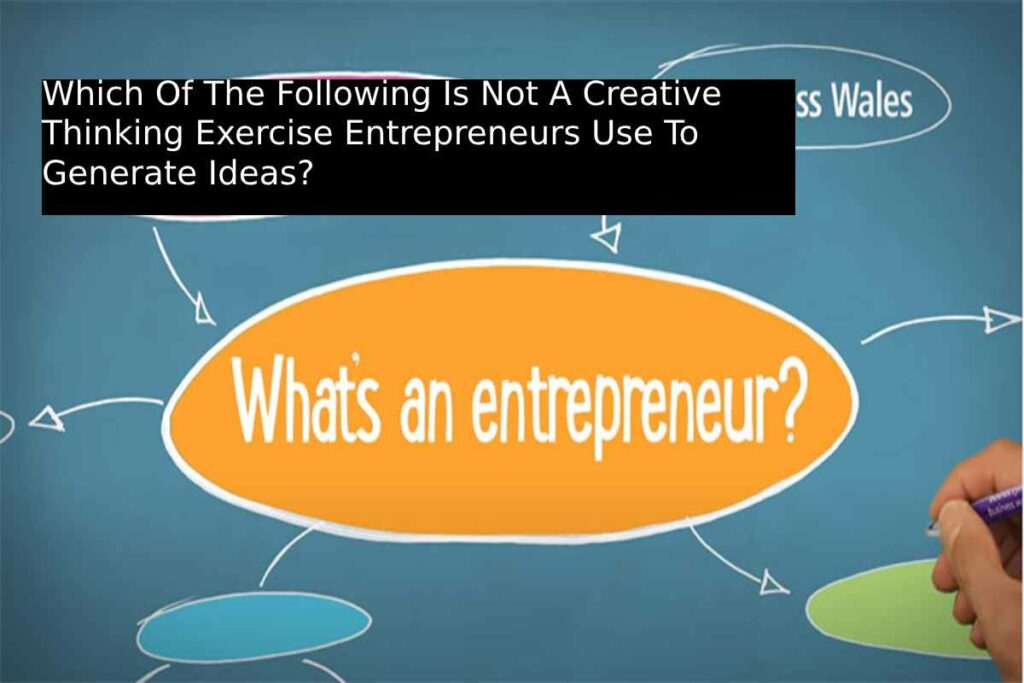
Entrepreneurs often use a variety of creative thinking exercises to generate ideas for their businesses and encourage innovation. They are intended to break free from conventional thinking patterns and encourage exploring new ideas.
The creative thinking exercises A, C, and D are legitimate creative thinking exercises for entrepreneurs. However, option B, judging each idea based on its realistic or unreal qualities, is not typically considered creative thinking. Let’s take a closer look at these exercises and explain why judging ideas based on their realism is not aligned with creative thinking.
The creative thinking exercises that entrepreneurs use to generate ideas include:
Challenging the usual involves questioning the status quo and looking for new ways to do things. For example, an entrepreneur might challenge the idea that a certain product or service can only be sold in a certain way.
Thinking backward involves starting with the end in mind and working backward to figure out how to get there. For example, an entrepreneur might think about what their ideal customer would want and then work backward to determine how to create a product or service that meets those needs.
Drawing idea maps: This involves creating a visual representation of your ideas, which can help you to see the connections between them and to identify new possibilities.
Brainstorming: This is a group activity in which members are encouraged to come up with as many ideas as possible, no matter how crazy they seem. This can help generate many new ideas, some of which might be the seeds of great businesses.
The creative thinking exercise entrepreneurs do not typically use is judging every idea as realistic. This is because entrepreneurs often look for new and innovative ideas, even if they seem unrealistic initially. They are willing to take risks and experiment and are not afraid to fail. Judging every idea as realistic or not can stifle creativity and prevent entrepreneurs from exploring new possibilities.
So, the answer is “Judge Every Idea as Realistic or Not.” This is not a creative thinking exercise that entrepreneurs typically use to generate ideas.
A. Challenge The Usual:
The Challenge the Usual creative thinking exercise involves interrogative the status quo and looking for new ways to do things. This can be a helpful exercise for entrepreneurs looking to come up with new ideas or improve their existing products or services.
Here are some questions you can ask yourself to help you challenge the usual:
What are the assumptions that we’re making about the way things are done?
Are there any other ways to do this?
What would happen if we did the opposite?
if we looked at this from a different perspective?
What are some new technologies or trends that could change the way we do things?
Once you’ve started to ask these questions, you can come up with new ideas for improving things. You might even come up with a new way of doing things that no one has ever thought of.
Here are some examples of how entrepreneurs have used the Challenge the Usual exercise to come up with new ideas:
Jeff Bezos challenged the idea that people would only buy books online. He saw the potential for online book sales, and he created Amazon.com, which is now the world’s largest online retailer.
Richard Branson challenged the idea that airlines had to be boring. He created Virgin Atlantic, known for its innovative and customer-focused approach.
Elon Musk challenged the idea that electric cars were boring and slow. He created Tesla, which is now one of the world’s most successful electric car companies.
The Challenge the Usual exercise can be a helpful way to develop new ideas and improve your existing products or services. This is a great exercise if you’re looking for a way to think outside the box.
B Draw Idea Maps:
Drawing idea maps is a creative thinking exercise that involves creating a visual picture of your ideas. This can help you to see the connections between your ideas and to identify new possibilities.
You will need a quantity of paper and a pen or draw to draw an idea map. You can also use a mind mapping software program if you prefer.
Start by writing your central idea in the middle of the page. Then, draw branches off of the central idea to represent different aspects of your idea. You can use different colors to represent dissimilar categories or ideas.
As you think of new ideas, add them to the map. You can also connect different ideas with lines to show how they are related.
Idea maps can be a helpful way to brainstorm new ideas, to organize your thoughts, and to visualize your goals. They can also be a great way to communicate your ideas to others.
Here are some tips for drawing idea maps:
Start with a central idea.
Use different colors to represent different categories or ideas.
Connect different ideas with lines to show how they are related.
Don’t be afraid to add new ideas as you think of them.
Have fun!
Here are some examples of idea maps:
A mind map of a business plan: This would typically include the company’s mission, vision, goals, strategies, and products or services.
mind map of a marketing campaign: This type of mind map would typically include the target audience, the message, the channels, and the metrics.
A mind map of a product development process: This type of mind map would typically include the problem, the solution, the features, the benefits, and the competition.
Idea maps can be a helpful tool for entrepreneurs and other creative thinkers. They can help you to come up with new ideas, to organize your thoughts, and to visualize your goals. If you’re looking for a way to improve your creativity, I encourage you to try drawing idea maps.
c. Think Backward:
Thinking backward is a creative thinking exercise that involves starting with the end in mind and working backwards to figure out how to get there. This can be a helpful exercise for entrepreneurs looking to come up with new ideas or improve their existing products or services.
Here are some steps on how to think backward:
Start with the end in mind. What is your desired outcome? What do you want to achieve?
Break down the end goal into lesser steps. What key steps need to be taken to achieve your goal?
Work backwards from the end goal. For each step, ask physically, “What needs to happen before this step can be completed?”
Identify the resources you need. What resources do you need to complete each step?
Create a timeline. When do you need to complete each step to achieve your goal?
Thinking backward can help you to see the big picture and to identify the steps that need to be taken to achieve your goal. It can also help you identify potential problems or challenges you might need to overcome.
Here are some examples of how entrepreneurs have used thinking backward to come up with new ideas:
Jeff Bezos thought backward from the goal of having a customer’s book deliver to their door within 24 hours. This led him to create Amazon.com, the world’s largest online retailer.
Richard Branson thought backward from the goal of creating an airline that was more fun and exciting than the competition. This led him to create Virgin Atlantic, known for its innovative and customer-focused approach.
Elon Musk thought backward from the goal of creating an electric car that was affordable and accessible to everyone. This led him to create Tesla, which is now one of the world’s most successful electric car companies.
Thinking backward can be a helpful way to come up with new ideas and to improve your existing products or services. If you’re looking for a way to think more strategically, I encourage you to think backward.
Thinking backward is a creative thinking exercise that involves starting with the end in mind and working backwards to figure out how to get there. This can be a helpful exercise for entrepreneurs looking to come up with new ideas or improve their existing products or services.
Here are some steps on how to think backward:
Start with the end in mind. What is your desired outcome? What do you want to achieve?
Break down the end goal into lesser steps. What key steps need to be taken to achieve your goal?
Work backwards from the end goal. For each step, ask physically, “What needs to happen before this step can be completed?”
Identify the resources you need. What resources do you need to complete each step?
Create a timeline. When do you need to complete each step to achieve your goal?
Thinking backward can help you to see the big picture and to identify the steps that need to be take to achieve your goal. It can also help you identify potential problems or challenges you might need to overcome.
Here are some examples of how entrepreneurs have used thinking backward to come up with new ideas:
Jeff Bezos thought backward from the goal of having a customer’s book deliver to their door within 24 hours. This led him to create Amazon.com, now the world’s largest online retailer.
Richard Branson thought backward from the goal of creating an airline that was more fun and exciting than the competition. This led him to create Virgin Atlantic, known for its innovative and customer-focused approach.
Elon Musk thought backward from the goal of creating an electric car that was affordable and accessible to everyone. This led him to create Tesla, which is now one of the world’s most successful electric car companies.
Thinking backward can be a helpful way to come up with new ideas and to improve your existing products or services. If you’re looking for a way to think more strategically, I encourage you to think backward.






